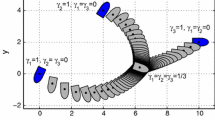Abstract
In this paper, we consider the problem of a kind of consensus problem among a collection of vehicles performing a shared task with 2-D Fornasini-Marchesini second local state-space (LSS) dynamical model by using intervehicle communication and output feedback themselves in which the weights of the corresponding edges are considered as the control variables. Firstly, it is shown that under certain conditions, the stability of a collection of N identical vehicles can be equivalently transferred into the stability analysis of a single vehicle with the same dynamics, modified by only a scalar, representing the interconnection, that takes values according to the eigenvalues of the weights matrix. Then, two types of networks, star-shaped networks and globally coupled networks, are studied in details. Secondly, the general description are presented for such consensus problem via the block diagram of information flow. Finally, a collection of vehicles with different 2-D LSS dynamical model is investigated.
Similar content being viewed by others
Explore related subjects
Discover the latest articles, news and stories from top researchers in related subjects.References
Bender J. G. (1991) An overview of systems studies of automated highway systems. IEEE Transactions on Vehicular Technology 40(1): 82–99
Boyd S. P., Ghaoui L. E., Feron E., Balakrishnan V. (1998) Linear matrix inequalities in system and control theory. SIAM, Philadelphia, PA
Buzogany, L. E., Pachter, M., d’Azzo, J. J. (1993). Automated control of aircraft in formation flight. In Proceedings of the AIAA Conference Guidance, Navigation, and Control (pp. 1349–1370).
Chai W. W., Chua L. O. (1995) Application of Kronecker products to the analysis of systems with uniform linear coupling. IEEE Transactions on Circuits and Systems-I 42(10): 775–778
Chen J. L., Chen X. H. (2001) Special matrices. Tsinghua, Beijing
Corts J., Martnez S., Bullo F. (2005) Spatially-distributed coverage optimization and control with limited-range interactions. ESAIM: Control, Optimisation and Calculus of Variations 11(4): 691–719
Corts J., Martnez S., Bullo F. (2006) Robust rendezvous for mobile autonomous agents via proximity graphs in arbitrary dimensions. IEEE Transactions on Automatic Control 51(8): 1289–1298
de Berg M., van Kreveld M., Overmars M., Schwarzkopf O. (2000) Computational geometry: Algorithms and applications (2nd ed.). Springer-Verlag, New York
Derenick J., Spletzer J., Hsieh A. (2009) An optimal approach to collaborative target tracking with performance guarantees. Journal of Intelligent and Robotic Systems 56: 47–67
Duan Z. S., Wang J. Z., Chen G. R., Huang L. (2008) Stability analysis and decentralized control of a class of complex dynamical networks. Automatica 44(4): 1028–1035
Fax J. A., Murray R. M. (2004) Information flow and cooperative control of vehicle formations. IEEE Transactions on Automatic Control 49(9): 1465–1476
Fornasini E., Marchesini G. (1978) Doubly-indexed dynamical systems: State-space models and structural properties. Mathematical Systems Theory 12(1): 59–72
Galkowski K., Rogers E., Xu S., Lam J., Owens D. H. (2002) LMIs-A fundamental tool in analysis and controller design for discrete linear repetitive processes. IEEE Transactions on Circuits Systems I, Fundamental Theory and Applications 49(6): 768–778
Gumel A.B., Ruan S., Day T. et al (2004) Modeling strategies for controlling SARS outbreaks. Proceedings of the royal society 271(1554): 2223–2232
Hinamoto T. (1993) 2-D lyapunov equation and filter design based on the Fornasini-Marchesinni second model. IEEE Transactions on Circuits Systems I, Fundamental Theory and Applications 40(2): 102–110
Huang L., Duan Z. S. (2003) Complexity in control science. Acta Automatica Sinica 29(5): 748–753
Jadbabaie A., Lin J., Morse A. S. (2003) Coordination of groups of mobile autonomous agents using nearest neighbor rules. IEEE Transactions on Automatic Control 48(6): 988–1001
Jaromczyk J.W., Toussaint G.T. (1992) Relative neighborhood graphs and their relatives. Proceedings of the IEEE 80(9): 1502–1517
Martnez S., Corts J., Bullo F. (2007) Motion coordination with distributed information. IEEE Control Systems Magzine 27(1): 75–87
Moreau L. (2005) Stability of multiagent systems with time-dependent communication links. IEEE Transactions on Automatic Control 50(2): 169–182
Ohara, A., & Sasaki, Y. (2001). On solvability and numerical solutions of parameter- dependent differential matrix inequality. In Proceedings of the IEEE Conference Decision Control, Orlando (pp. 3593–3594) FL.
Olfati-Saber R., Murray R. M. (2004) Consensus problems in networks of agents with switching topology and time-delays. IEEE Transactions on Automatic Control 49(9): 1520–1533
Packard A., Doyle J. C. (1993) The complex structured singular value. Automatica 29(1): 71–109
Ren W., Beard R. W., Atkins E. M. (2007) Information consensus in multivehicle cooperative control: Collective group behavior through local interaction. IEEE Control Systems Magazine 27(2): 71–82
Schaub H. et al (2000) Spacecraft formation flying control using mean orbital elements. Journal of Astronautical Science 48(1): 69–87
Smith, T. R., mann, H. H., & Leonard, N. E. (2001). Orientation control of multiple underwater vehicles, In Proceedings of the 40th IEEE Conference Decision and Control (pp. 4598–4603).
Sun K., Zheng D. Z., Lu Q. (2003) Splitting strategies for islanding operation of large-scale power systems using OBDD-based methods. IEEE Transactions on Power Systems 18(2): 912–923
Yamaguchi H., Arai T., Beni G. (2001) A distributed control scheme for multiple robotic vehicles to make group formations. Robotics and Autonomous systems 36(4): 125–147
Yan X., Zou Y. (2008) Optimal and sub-optimal quarantine and isolation control in SARS epidemics. Mathematical and Computer Modeling 47(1): 235–245
Yan X. F., Zou Y. (2009) Isolation treatment strategy for emergency control. Journal of systems engineering 24(2): 129–135
Author information
Authors and Affiliations
Corresponding author
Additional information
This work was supported in part by the National Natural Science Foundation of P.R. China under Grant 60874007 and the Research Fund for the Doctoral Program of Higher Education 200802550024.
Rights and permissions
About this article
Cite this article
Liu, X., Zou, Y. A consensus problem for a class of vehicles with 2-D dynamics. Multidim Syst Sign Process 21, 373–389 (2010). https://doi.org/10.1007/s11045-010-0121-4
Received:
Revised:
Accepted:
Published:
Issue Date:
DOI: https://doi.org/10.1007/s11045-010-0121-4




